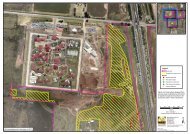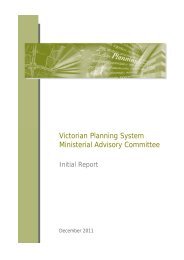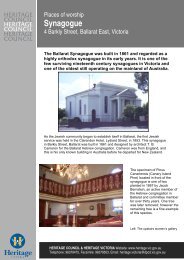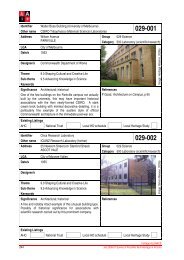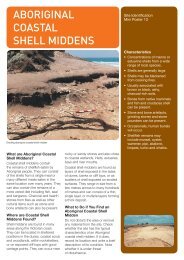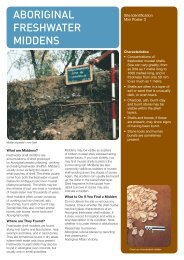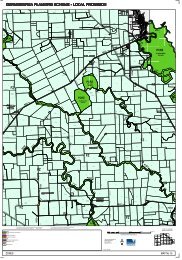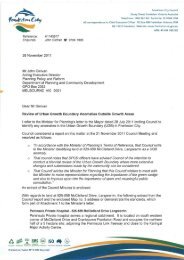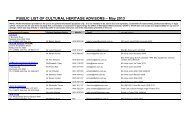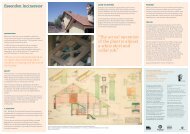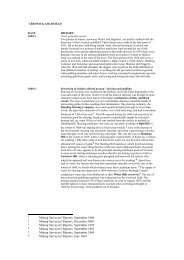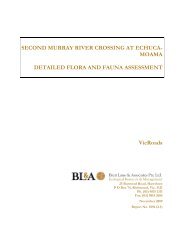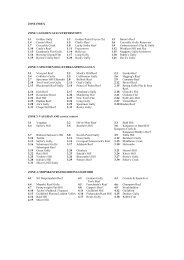Bendigo General History - Department of Planning and Community ...
Bendigo General History - Department of Planning and Community ...
Bendigo General History - Department of Planning and Community ...
Create successful ePaper yourself
Turn your PDF publications into a flip-book with our unique Google optimized e-Paper software.
1857-1902: Elysian Flat Goldfield: The lead on this flat was to prove a lengthy one, <strong>and</strong> where mining<br />
first commenced, the shafts were down from 20 to 40 feet. As the lead was traced in a northwesterly<br />
direction the sinking increased, finally reaching depths <strong>of</strong> 100 to 120 feet, forming a<br />
deep lead. The lead was also followed south where it gradually shallowed, trailing <strong>of</strong>f into the<br />
scrub where it was known as the Shallow Diggings. Eventually the bed <strong>of</strong> this ancient, buried<br />
stream was followed along its tortuous path for over 3 miles. A visitor to the new rush in<br />
mid-November 1857, estimated the population at no less than 600. He observed that with one<br />
exception all the stores on the Whipstick Diggings had been moved or were in the process <strong>of</strong><br />
removal to Elysian Flat ... Towards the close <strong>of</strong> November the population had risen to 1500,<br />
some 700 <strong>of</strong> them miners ... Many miners were coming from S<strong>and</strong>hurst <strong>and</strong> Epsom. The<br />
Epsom diggers were renowned for their skill in sinking deep shafts in alluvial ground ... Each<br />
day, newcomers arrived at Elysian Flat, but because <strong>of</strong> water shortage, <strong>and</strong> many also left.<br />
Washdirt had to be carted to a creek 3/4 miles to be treated, the cartage costing 15 shillings<br />
per load. During December ... down on the flat were between 50 <strong>and</strong> 60 stores. They had<br />
formed a street some 120 yards long ... Many miners were now bringing their families. As<br />
the first month <strong>of</strong> 1858 came to a close, the population on the diggings was estimated at<br />
2,000. The first hotel was under construction. Sometimes the run <strong>of</strong> the lead was lost, only to<br />
be found again by some miner who chanced to sink in the right place. Early mining on<br />
Elysian Flat became a series <strong>of</strong> minor rushes. The first school at Elysian Flat was opened on<br />
26 April 1858. The Whipstick <strong>and</strong> Elysian Flat Water Company - formed to create a<br />
permanent water supply for the goldfield. Eventually two sites were chosen close to Elysian<br />
Flat, <strong>and</strong> a contract for the sinking <strong>of</strong> one shaft <strong>and</strong> the excavation <strong>of</strong> a reservoir was let to<br />
McNair <strong>and</strong> Co. By early June, the excavation <strong>of</strong> a dam 200 feet long, 18 feet wide, <strong>and</strong> 6<br />
feet in depth was commenced, while the shaft was almost a hundred feet in depth ... After<br />
reaching the contracted depth <strong>of</strong> 150 feet, the shaft was making water very slowly - a 1/4 pint<br />
per minute ... The last known report 23 Sept 1858 “at Elysian Flat, the respective works <strong>of</strong><br />
Mr. Benson <strong>and</strong> Messrs. McNair <strong>and</strong> Sayers, still progressed slowly, <strong>and</strong> there is little doubt<br />
by the time the warm weather sets in, water to a certain extent will be available, at either,<br />
though <strong>of</strong> course on a very limited scale”. By the close <strong>of</strong> 1858 the Elysian Flat Rush was<br />
past its peak, the population considerably reduced, to dwindle further over the years. Series<br />
<strong>of</strong> rushes: worked out by July 1858, known as The Shallow Rush. August 1858 - 2 miles east<br />
<strong>of</strong> Elysian Flat known as Black Rock Flat. During August 1858, a survey was commenced<br />
for the site <strong>of</strong> the township <strong>of</strong> Elysian Flat. The township was to be on rising ground a short<br />
distance west <strong>of</strong> the Elysian Flat Creek ... The town site was gazetted the Township <strong>of</strong><br />
Neilborough on 3 August 1860. In 1865 Neilborough was included in the Borough <strong>of</strong><br />
Raywood at its formation. The Borough <strong>of</strong> Raywood eventually amalgamated with the Shire<br />
<strong>of</strong> Marong in 1915. Early in 1859 the population <strong>of</strong> Elysian Flat declined. Occasionally there<br />
were minor rushes to various parts <strong>of</strong> the flat, but most alluvial mining was confined to the<br />
lower end <strong>of</strong> the flat in deep sinking. The last mining on the deep lead was in 1902, where<br />
Morshead’s shaft reached a depth <strong>of</strong> 121 feet. This was the deepest shaft on the Elysian Flat<br />
alluvial, <strong>and</strong> Morshead’s mine was called the Ram’s Horn. 1<br />
1857: Interest quickened with each reef opened <strong>and</strong> with growing awareness <strong>of</strong> the<br />
potential value <strong>of</strong> the crushing machine. It came to be accepted that in the reefs lay any future<br />
development <strong>of</strong> the field. Unfortunately lack <strong>of</strong> capital excluded most diggers from<br />
participation. A first attempt to grapple with the problem was made at a meeting at the<br />
Criterion Hotel in June 1857 when forty or fifty miners formed the <strong>Bendigo</strong> Quartz Mining<br />
Company, each paying a membership fee <strong>of</strong> five shillings <strong>and</strong> promising a weekly<br />
contribution <strong>of</strong> a similar amount, in order to raise capital. Each was allotted a single share.<br />
Usually regarded as the first mining company formed on <strong>Bendigo</strong>, it did not meet with<br />
marked success but, at least, it represented a beginning. 2<br />
1857-1859: In other respects the field was dying. At Epsom the ‘cement’ was yielding payable results in<br />
the late fifties with crushing; the Huntly alluvials were mostly deep leads beyond the scope <strong>of</strong><br />
the individual miner. As a final gesture the Camp Reserve was thrown open to digging in<br />
1859 but yielded little. By contrast, the achievement <strong>of</strong> the reefers dispelled any lingering<br />
doubts <strong>of</strong> the potential <strong>of</strong> the reefs. In April 1859 the first ‘golden cakes’ went on display.<br />
Sibley <strong>and</strong> Company showed a huge ‘cake’ <strong>of</strong> 1,230 ounces <strong>of</strong> solid gold won from eighty<br />
tons <strong>of</strong> stone at Ironbark Gully. That produced by the Canadian, Richard Burrowes <strong>and</strong> his<br />
partners from their claim on the South Victoria reef, represented an even richer return. Its 730<br />
ounces had come from a mere forty-five tons <strong>of</strong> stone. 3<br />
1 Perry, 1975, pp42-62<br />
2 Cusack, 1973, p126<br />
3 Cusack, 1973, p126



